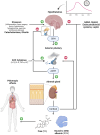The Glucocorticoid Receptor: Isoforms, Functions, and Contribution to Glucocorticoid Sensitivity
- PMID: 38551091
- PMCID: PMC11244253
- DOI: 10.1210/endrev/bnae008
The Glucocorticoid Receptor: Isoforms, Functions, and Contribution to Glucocorticoid Sensitivity
Abstract
Glucocorticoids exert pleiotropic effects on all tissues to regulate cellular and metabolic homeostasis. Synthetic forms are used therapeutically in a wide range of conditions for their anti-inflammatory benefits, at the cost of dose and duration-dependent side effects. Significant variability occurs between tissues, disease states, and individuals with regard to both the beneficial and deleterious effects. The glucocorticoid receptor (GR) is the site of action for these hormones and a vast body of work has been conducted understanding its function. Traditionally, it was thought that the anti-inflammatory benefits of glucocorticoids were mediated by transrepression of pro-inflammatory transcription factors, while the adverse metabolic effects resulted from direct transactivation. This canonical understanding of the GR function has been brought into question over the past 2 decades with advances in the resolution of scientific techniques, and the discovery of multiple isoforms of the receptor present in most tissues. Here we review the structure and function of the GR, the nature of the receptor isoforms, and the contribution of the receptor to glucocorticoid sensitivity, or resistance in health and disease.
Keywords: glucocorticoid receptor; glucocorticoid receptor isoforms; glucocorticoid sensitivity; glucocorticoids; hypothalamic-pituitary-adrenal axis.
© The Author(s) 2024. Published by Oxford University Press on behalf of the Endocrine Society.
Figures




References
-
- Chrousos GP. The hypothalamic-pituitary-adrenal axis and immune-mediated inflammation. N Engl J Med. 1995;332(20):1351‐1362. - PubMed
-
- Galon J, Franchimont D, Hiroi N, et al. Gene profiling reveals unknown enhancing and suppressive actions of glucocorticoids on immune cells. FASEB J. 2002;16(1):61‐71. - PubMed
Publication types
MeSH terms
Substances
Grants and funding
LinkOut - more resources
Full Text Sources
Medical
Molecular Biology Databases
Miscellaneous

